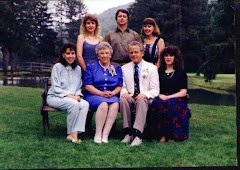 This is clothing from I. B. Bernstein's being dried on the town square after the flood.
This is clothing from I. B. Bernstein's being dried on the town square after the flood.
The bridge that was built after the '42 flood is in the process of being replaced right now. It is causing yers truly to drive extra miles in order to head over the hill to Smethport, but I know it has been 66 years so it is time.


Weather conditions for the past several weeks have reminded this writer very forcefully of a similar period during the calendar year 1942 when much more often than not thunderstorms of a drenching nature were prevalent throughout the north central Pennsylvania area which we have called "home" for more than eight decades at this writing. In fact, there had been such frequent powerful storms that the soil in the vicinity was thoroughly soaked, and incapable of absorbing any more precipitation.
It was under such conditions that cloudburst-type storms hit the Allegheny River valley, as well as its tributary streams in this vicinity -- Fishing Creek, Sartwell Creek, Lillibridge Creek, Two Mile Creek and Annin Creek, to list just the nearest-by. Since the completely saturated hillsides adjoining these waterways could not absorb much, if any, of the drenching downpour, the waters were diverted to each of the streams in overpowering surges, turning each into a raging torrent. The effect of all this on Lillibridge Creek had the greatest effect on residential areas of Port Allegany, as well as roaring down Mill Street, Arnold Avenue, Maple Street, Arnold Avenue, Broad and Chestnut streets to Church, Main, Pearl streets, and Railroad Avenue.
While all these areas were being affected, yours truly, with Mother and sister, Mary, were all sitting anxiously in the living room of the family homestead at 300 Chestnut. All of us were deeply concerned at the sight of smoke rising in the western sky, but unable to learn the source of such with communications not operating, and could only speculate that whatever was burning must surely be in the downtown business area, where the family-owned business was located.
Finally, about 11 a.m., unable to stand the uncertainty any longer, yers truly decided to try to reach the downtown area by the favored transportation for a 15-year-old PAHS junior, the aluminum-framed bicycle. Should have known better, but the flood-expanded Lillibridge Creek took control of our effort in the middle of Broad street, washing the bike from under us. Luckily the writer was able to avoid being carried downstream (or should it be "downstreet"?] by the raging torrent, retrieved the bike and returned to our home to await a later try, about 1 p.m. Succeeded in following Ann street down to Maple, and thence down to the R-A building, which thankfully still existed, contrary to our earlier premonitions. Some four feet, more or less, had invaded the building, carrying with it large accumulations of "flood mud" which filled the tiny sections of the foundry type cases and brought on a flushing-out process which continued for months, and in some cases for years, after the momentous July 18th catastrophe. Most of the machinery involved in producing your hometown newspaper was at least temporarily inactivated, and for a couple issues after the flood, the newspaper appeared with extensive cooperation from other publications in Smethport, Eldred, Coudersport and Wellsboro. Also greatly-affected were every downtown retail outlet. One of our strongest memories is of clotheslines strung across the public square with clothing items from I.B.Bernstein's men's store "hung out to dry". Other retail owners had become janitors of sorts, involved in scooping flood mud off the floors of their respective places of business and sorting merchandise to determine future salability, if any such existed.
It was under such conditions that cloudburst-type storms hit the Allegheny River valley, as well as its tributary streams in this vicinity -- Fishing Creek, Sartwell Creek, Lillibridge Creek, Two Mile Creek and Annin Creek, to list just the nearest-by. Since the completely saturated hillsides adjoining these waterways could not absorb much, if any, of the drenching downpour, the waters were diverted to each of the streams in overpowering surges, turning each into a raging torrent. The effect of all this on Lillibridge Creek had the greatest effect on residential areas of Port Allegany, as well as roaring down Mill Street, Arnold Avenue, Maple Street, Arnold Avenue, Broad and Chestnut streets to Church, Main, Pearl streets, and Railroad Avenue.
While all these areas were being affected, yours truly, with Mother and sister, Mary, were all sitting anxiously in the living room of the family homestead at 300 Chestnut. All of us were deeply concerned at the sight of smoke rising in the western sky, but unable to learn the source of such with communications not operating, and could only speculate that whatever was burning must surely be in the downtown business area, where the family-owned business was located.
Finally, about 11 a.m., unable to stand the uncertainty any longer, yers truly decided to try to reach the downtown area by the favored transportation for a 15-year-old PAHS junior, the aluminum-framed bicycle. Should have known better, but the flood-expanded Lillibridge Creek took control of our effort in the middle of Broad street, washing the bike from under us. Luckily the writer was able to avoid being carried downstream (or should it be "downstreet"?] by the raging torrent, retrieved the bike and returned to our home to await a later try, about 1 p.m. Succeeded in following Ann street down to Maple, and thence down to the R-A building, which thankfully still existed, contrary to our earlier premonitions. Some four feet, more or less, had invaded the building, carrying with it large accumulations of "flood mud" which filled the tiny sections of the foundry type cases and brought on a flushing-out process which continued for months, and in some cases for years, after the momentous July 18th catastrophe. Most of the machinery involved in producing your hometown newspaper was at least temporarily inactivated, and for a couple issues after the flood, the newspaper appeared with extensive cooperation from other publications in Smethport, Eldred, Coudersport and Wellsboro. Also greatly-affected were every downtown retail outlet. One of our strongest memories is of clotheslines strung across the public square with clothing items from I.B.Bernstein's men's store "hung out to dry". Other retail owners had become janitors of sorts, involved in scooping flood mud off the floors of their respective places of business and sorting merchandise to determine future salability, if any such existed.
Before signing off these reflections, we should report the source of the thick, black smoke noticed by Mom, sis Mary and myself as we sat together in the homestead living room early in the day. Seems that the furnace in the Free Methodist parsonage formerly located on West Mill Street malfunctioned in some way due to the flooded basement, setting the structure ablaze. The building then floated off its foundation and smashed into the Kanter Silk Mill across the street, setting it ablaze and it was ultimately destroyed by the ensuing flames. Fire prevention steps were virtually impossible due to the deep waters from the Allegheny. Not the reason we had feared, but still a considerable loss to the town's industrial scene. These are the highlights of what the writer can remember at the moment. Maybe more at a future writing!!!








